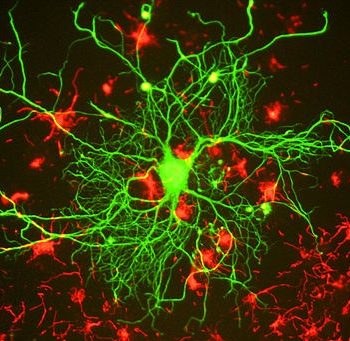Returning home from a tour of duty in Afghanistan, Sgt. Thomas James Brennan found his thoughts ineluctably drawn back: “I saw disturbed patches of dirt as threats – potential roadside bombs – loud noises made me jump and silence made me paranoid. Seven months in a combat zone makes it difficult to switch off.”(a)
The psychological effects of traumatic events such as war, rape, and family violence can reverberate long past the event itself. Some individuals develop post-traumatic stress disorder (PTSD), experiencing spontaneous flashbacks and nightmares; avoidance of trauma-associated places, events, and objects; and hyperarousal symptoms such as insomnia, poor concentration, hypervigilance, and irritability.(b) Approximately 6.8% of Americans suffer from post-traumatic stress disorder.
Currently, the most effective treatment for PTSD is exposure therapy, which involves repeated exposure to trauma-related situations, typically by recalling the traumatic memories in a safe environment like a therapist’s office. Although exposure therapy has been shown to improve symptoms 60% to 80% on average, the return of fear following exposure therapy is well documented.1
My research attempts to understand why fear memories are so hard to erase. Fear has been studied in laboratory rats using an experimental paradigm known as fear conditioning. First, in the training phase, a rat is presented with a visual or auditory cue (e.g., a tone or light) followed by a shock to the foot. After a few pairings, the rat freezes when it experiences the cue (an innate fear response).(c) Then, the experiment moves into the extinction phase, when the newly formed memory is extinguished. In this phase, the rat is repeatedly presented with the cue but no shock, and eventually the rat stops freezing.
Unfortunately, it turns out that the fear memory persists beyond the extinction phase, as evidenced by a variety of tests. For example, the rat will freeze in response to the cue when presented one month later, a phenomenon known as spontaneous recovery. Many neuroscientists believe this occurs because extinction does not actually erase the fear memory, but instead creates a new “no-fear” memory that temporarily competes with the existing fear memory. If this theory is correct and applicable to humans, it could explain the limitations of exposure therapy for PTSD: as the strength of the new, more positive memory created in therapy wears off, the old memory can come back to haunt the patient.
My colleagues and I have formalized this idea using a mathematical model of learning that determines when a new memory will be created and when an old memory will be modified.2 The essence of the model is that the rat is engaged in a form of statistical reasoning about the hidden causes of its observations. Just as a human might infer a hidden plumbing problem when the water stops running, the rat tries to interpret information from its surroundings to determine the hidden cause behind events like the cue and the shock.
These interpretations rely on predictions. The person in our example may know from past experience that plumbing malfunctions can cause the water to stop running, so it makes sense for them to predict that the current lack of water is caused by a plumbing problem, even though they can’t see the cause. Similarly, the rat learns predictions about cues and shocks each time it infers something about the hidden causes connecting the two, and stores these predictions in its memory. New sensory information leads the rat to either update its predictions for a previously inferred cause (hence modifying an old memory) or to infer a new cause (hence creating a new memory).
The driving force underlying such learning is the prediction error: the size of the discrepancy between the rat’s prediction and its actual experience. At the beginning of training, the rat does not have any familiarity with the environment. As it experiences cues followed by shocks, it posits a hidden cause that generates cues paired with shocks. The onset of the extinction phase produces a large prediction error: the rat predicts that a shock will follow each cue, but now only observes cues without shocks. When the prediction error is sufficiently large, the rat posits a new, hidden cause that generates cues without shocks. At the end of the extinction phase, the rat has two memories (one for each hidden cause); the “cue-shock” memory is still present alongside the “cue-no-shock” memory.
In our model, the size of the prediction error (the difference between the rat’s existing predictions and its new experiences) determines whether the old memory will be updated or a new memory will be formed alongside the old memory. We hypothesized that modification of the original fear memory – rather than creation of a new memory – might occur if the transition between training and extinction happened gradually, with the frequency of shocks slowly reduced rather than abruptly ceased as in standard extinction experiments. Our model predicts that in gradual extinction, the rat will only experience small prediction errors, making it more likely to modify its existing memory than create a new memory.
We tested this prediction and found that rats that underwent gradual extinction showed no evidence of spontaneous recovery of fear (i.e. freezing when presented with the cue one month later), whereas rats that underwent standard, abrupt extinction did demonstrate spontaneous recovery.3 This is remarkable because the rats in the gradual extinction group were actually shocked more times during the extinction phase (though less frequently) than during the initial training phase. We also tested a control group of rats that experienced the same number of shocks during extinction as the gradual extinction group but with increasing, rather than decreasing, frequency. This group also showed recovery of fear. Thus, the gradual elimination of shocks was the key ingredient to fear erasure.
This research offers an interesting case study of how mathematical modeling can lead to novel predictions, suggesting that the development of new psychiatric treatments may benefit from thinking in terms of mathematical models. We have recently begun replicating the experiment in humans using the same cues and shocks as in the rat experiment, but with skin conductance as a measure of fear.(d) The preliminary results are promising, although the sample size is still too small to draw any strong conclusions.
If demonstrated effective in humans, gradual extinction holds the promise of overcoming some of the shortcomings of existing fear erasure techniques. Current approaches to exposure therapy are essentially a form of standard, rather than gradual, extinction because they present a fear-associated object in the absence of aversive consequences. Incorporating gradual extinction into therapeutic techniques might involve presenting low-intensity simulations of traumatic experiences, then reducing their frequency over time. Although much work remains to be done, gradual extinction could one day be relevant to treating PTSD, anxiety, and possibly even drug addiction.
Endnotes
- E.B. Fox and B.O. Rothbaum (2003) “Is the efficacy of exposure therapy for PTSD augmented with the addition of other CBT procedures?” Psychiatric Annals, 33: 47-53. S.J. Rachman (1989) “The return of fear: review and prospect,” Clinical Psychology Review, 9: 147-168.
- Samuel J. Gershman, David M. Blei, and Yael Niv (2010) “Context, learning, and extinction,” Psychological Review, 117(1): 197-209.
- Samuel J. Gershman, Carolyn E. Jones, Kenneth A. Norman, Marie-H. Monfils, and Yael Niv (2013) “Gradual extinction prevents the return of fear: Implications for the discovery of state,” Frontiers in Behavioral Neuroscience, 7: 164.
Sidenotes
- (a) About 130,000 U.S. military personnel received a diagnosis of PTSD between 2000 and 2012.
- (b) PTSD was first classified as a psychological disorder in 1980, following the mental trauma caused by the Vietnam War. Early researchers and anti-war activists sometimes called it “post-Vietnam syndrome.” Similar conditions had previously been referred to as “shell shock” during World War I and as “gross stress reaction” after World War II.
- (c) Scientists hypothesize that the “freeze” response evolved as an alternative to “fight” or “flight” defenses in animals that may be more protected by playing dead than by moving in response to a threat.
- (d) The high density of sweat glands on the human hand causes the skin to conduct more electricity in a state of arousal, defined as the experience of energizing emotions such as excitement, nervousness, or fear. Psychologists frequently measure this conductivity, called skin conductance response, to gauge the emotional state of human subjects.





